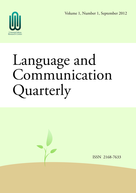


Volume 10 Issues 1-4 (2021-12-31)
Volume 9 Issues 1-4 (2020-12-31)
Volume 8 Issues 1&2 (2019-06-30)
Volume 7 Issues 3&4 (2018-12-31)
Volume 7 Issues 1&2 (2018-06-30)
Volume 6 Issues 3&4 (2017-12-31)
Volume 6 Issues 1&2 (2017-06-30)
Volume 5 Issues 3&4 (2016-12-31)
Volume 5 Issues 1&2 (2016-06-30)
Volume 4 Issues 3&4 (2015-12-31)
Four categories of affect-marked lexemes are prominent in a variety of languages, suggesting thereby that all four may be universal, cross-cultural categories: slang, swearwords, honorifics and terms of endearment. Each of these categories (as well as the closely associated ones of nicknames and pet names) is "designed" to serve specific social functions. Data from China and the U.S. indicate that these lexemic categories overlap with each other both functionally and in terms of the specific lexemes that comprise them (Moore et al. 2010). However, they can be distinguished in terms of their prototypical forms and functions. Furthermore, the prototypical functions correspond to the universal relational models identified by Alan Fiske (1991). This paper proposes that the apparent universality of both the lexemic categories and Fiske’s relational models together reveal fundamental aspects of social structure at the behavioral and linguistic levels.
This paper uses critical discourse analysis (CDA) as the analytical approach to analyze the website of English Program In Korea (EPIK), which was launched by the Korean Ministry of Education in 1995 to cope with the Korea’s domestic and the international demand for better English communicative competence. The analysis focuses on (1) the relationship constructed between the producer (the English Program in Korea established by the Korean government) and the consumer (foreigners seeking a teaching job, potential native English teachers in Korea; (2) the images created; and (3) social conditions of interpretation. The findings of this study demonstrate how English education policy is implicated in power, and how various ideologies were expressed in the texts and pictures of the EPIK website.
In this article the researcher shares the research and theory related to teaching strategies for the purpose of understanding the ways by which children make sense of the novel metaphors and use these metaphors. The researcher chose to work with Greek children on a metaphor taken from politics and the language of economy: the “debt’s haircut”. Although the term “haircut” has been used in economic language context for years, it was during the last two years that this term was used as a novel metaphor by the Greek people, especially the students in primary education. From this perspective, the researcher accepts it as a novel metaphor and used it for the current case study. Cultural implications for understanding and using “haircut” as a metaphor for the Greek society are examined in children’s talk, writing, and drawings at school for the purpose of introducing innovative and effective teaching strategies in language acquisition.
This literary piece seeks to identify the impact pragmatic competency has on student learning of a non-native language. Educational organizations have been faced with new challenges due to the internationalization and globalization of education. As such, educational organizations must seek effective strategies to meet their primary goal of educating students. Due to this increase in cultural and social interactions, pragmatic competency becomes ever more important. Though pragmatic competency is accepted as being integral to new language acquisition, currently, there is no final consensus about which methods of instruction and assessment are best. The contradiction between pragmatic competency importance and practice is further identified and explored.